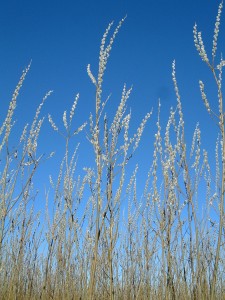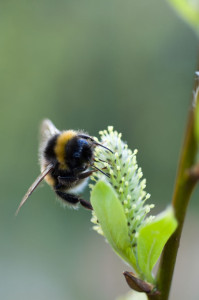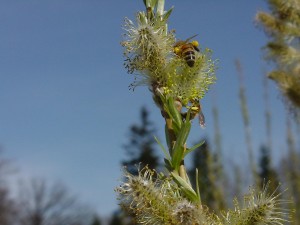Why aren’t we growing more willows as an abundant source of pollen for bees?
Willows are sometimes called the Easter Tree as they come into bloom early in spring. Male varieties can be particularly showy and produce prolific displays of golden catkins. They aren’t just nice to look at – they provide a lifeline to foraging bees by providing an abundant source of pollen and nectar when there aren’t many alternatives. This essential ecosystem service has so far been under exploited in commercial food production but could be a major fringe benefit of growing short rotation coppice (SRC) willow as an energy crop.
The valuable contribution that different willow species provide is widely recognised by bee keepers. Frank Greenaway a bee keeper in Carmarthenshire has planted willows to help his bees through the late winter lean period. He explained why a plentiful supply of early pollen is so important:
“The adult bees feed a mixture of pollen and nectar to their grubs. It is the protein content of the pollen that they need to grow from egg to adult bee, nectar only gives them energy. Adult bees eat a lot of nectar to enable them to keep warm and fly but actually eat very little pollen as all their growing is complete. When a colony gets going in the spring the queen starts laying eggs like mad and the demand is for pollen to feed the grubs – this can be in February or even earlier in mild years – it is usually the availability of fresh pollen (and the odd day above 12 degrees C to allow them to collect it) that is the controlling factor. A healthy hive normally has some reserves of honey even at the end of winter but they never seem to have enough pollen”.
In the face of the decline in pollinator populations (there has been a 54% fall in honeybee hive numbers in England between 1985 and 2005), it’s high time that this potential was recognised and utilised by the wider farming and horticulture industries. Early pollen derived protein from willow could be key to building up insect population numbers and influence the level of pollination in both food crops and wild plant populations later in the season. Currently around 20% of UK cropland is covered by insect pollinated crops (such as apples, plums, pears and oilseed rape) and the value of pollination to UK agriculture has been estimated at £400 million.

The biomass willow variety Loden can produce over 400 catkins on each coppice stool aged 2-3 years. (Image courtesy of Stg Larsson)
It’s possible that SRC willow could be planted in conjunction with food crops and provide essential pollination services. A quick trawl of the web indicates that the source is plentiful and quality of protein in the pollen is good – very good. Various online sources suggest that willows can yield 1,500 pounds of pollen per acre (1.68 tonnes per hectare). This sounds like an awful lot but is not as fanciful as you might imagine. A mature stand of SRC may have around 400 or more catkins per stool and based on a stocking rate of 15,000 plants per hectare that’s 6 million catkins. Each of these catkins would have to produce just 0.28 grams of pollen. To put that into context that’s a lot less than a tenth of a teaspoon of sugar.
A typical honey bee colony consisting of around 20,000 bees collects around 57 kg of pollen per year. If we assume a pollen yield from male SRC willow catkins of 1.68 tonnes/year, a 1 hectare plantation could potentially provide enough pollen to support almost 30 colonies, that’s 600,000 honey bees!
The quality of the protein seems to vary between species. The American pussy willow (Salix discolor) has a crude protein content of 21.9% whilst the crack willow (Salix fragilis) is 14.8 – 15.1%. Anything above 20% is considered a good pollen source. Research suggests that bumblebees reared on high quality pollen result in larger workers that are more efficient at nectar collection, can fly in cooler temperatures, can collect from deeper flowers and may be less prone to predation.

Bees also need nectar. This bumblebee is feeding from a female willow catkin. (Image courtesy Jason Ingram www.jasoningram.co.uk)
As there are around 350 species of willows worldwide and countless hybrid combinations the odds of being able to actively select for increased pollen yield and quality are high. The UK SRC willow breeding programme has created crosses involving around 55 species of Salix, many of which have a large displays of male catkins. Until now the selection has been based on biomass yield rather than gender, pollen yield and crude protein content. As a result most of the varieties available are females that flower in Jan-Feb. However, the selection criteria could be expanded to look for male genotypes that provide a wealth of pollen at crucial times of the year – a few weeks in advance of key food crops grown in the UK.
The table below shows the time when different willow species and cultivars come into flower in the UK. Many of these varieties have already been used in breeding and have produced male genotypes with abundant pollen.
| Time of flowering | Species | Cultivar names | Gender | Used in biomass breeding programmes | Notes |
| January | Salix schwerinii | Hilliers | Female | Yes | |
| S. aegyptiaca | Male | Yes | Prolific catkins | ||
| Early Feb | S. koriyanagi | Female | Yes | ||
| S. viminalis x schwerinii | Olof*, Sven* | Male | Yes | ||
| Mid – Late Feb | S. sachalenensis | Sekka | Male | Yes | Prolific catkins |
| S. x erdingeri (daphnoides x caprea) | Binea | Male | |||
| Early March | S. dasyclados ( = S. burjatica) | Loden*, Korso | Male | Yes | Prolific catkins |
| S. purpurea | Eugenii & Uralensis | Yes | |||
| S. appennina | Male | ||||
| S. kinuyanagi | Male | ||||
| S. x savensis (alba x fragilis x caprea) | Male | ||||
| March-April | S. viminalis | Jorr* | Male | Yes | |
| S. purpurea | Richardtii, Dark Dicks and Green Dicks | Male | |||
| S. daphnoides | Continental Purple, Blue Streak, Aglaia | Male | |||
| S. irrorata | Male | ||||
| S. caprea | Male | Yes | Prolific catkins | ||
| S. miyabeana | Purpurescens & Shrubby willow | Male | Yes | ||
| S. repens | Argentea | Male | |||
| April – May | S. hookeriana (= candida) | Male | Yes | Prolific catkins | |
| S. glaucophylloides | Female | Yes | |||
| S. redheriana | Female | Yes | |||
| S. eriocephala | Male | Yes | |||
| S. triandra | Black Hollander | Male | Yes | ||
| S. x sericans (caprea x viminalis) | Coles | Male | Yes | ||
| S. bebbiana | Male | Yes | |||
| May-June | S. x rubens (alba x fragilis) | Basfordiana | Male | ||
| S. pentandra | Patent Lumley | Male | |||
| S. triandra | Black German | Male | |||
| May – Sept | S. triandra | Semperflorescens | Male | Flowers throughout summer |
* Biomass willow variety
So there’s massive potential but we need some basic research done. Existing male varieties need to be screened to see how attractive they are to bees, how much pollen they yield and the quality of pollen produced. Trials need to be set up that identify if SRC can increase pollinator numbers and if the yield of adjacent food crops can be increased. Also, a cost benefit analysis needs to be done to see if there is any effect in economic returns for farmers based on the land lost to SRC cultivation versus the benefits in food and energy produced.
If the pollinator services of SRC willows can be proven then growers should be encouraged with incentives.
I think this presents a fantastic multi- dimensional opportunity – to plant a crop for energy use that could also increase bee numbers and thereby augment food production. This is the sort of R&D work that deserves public funding!
